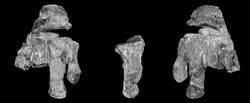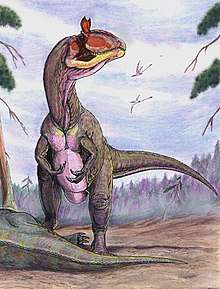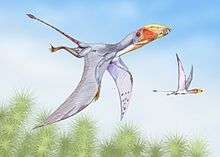Hanson Formation
| Hanson Formation Stratigraphic range: Hettangian-Pliensbachian ~196.5–183 Ma | |
|---|---|
| Type | Geological formation |
| Unit of | Victoria Group |
| Sub-units | Three informal members |
| Underlies | Prebble Formation |
| Overlies | Falla Formation |
| Thickness | 237.5 m (779 ft) |
| Lithology | |
| Primary | Sandstone, tuffite |
| Location | |
| Coordinates | 84°18′S 166°30′E / 84.3°S 166.5°ECoordinates: 84°18′S 166°30′E / 84.3°S 166.5°E |
| Approximate paleocoordinates | 57°30′S 35°30′E / 57.5°S 35.5°E |
| Region | Mount Kirkpatrick, Beardmore Glacier |
| Country |
|
The Hanson Formation is a geologic formation on Mount Kirkpatrick, Antarctica. It is one of only two major dinosaur-bearing rock formations found on the continent of Antarctica to date; the other is the Santa Marta Formation from the Late Cretaceous. The formation has yielded only a handful of Mesozoic specimens so far and most of it is as yet unexcavated. Part of the Victoria Group of the Transantarctic Mountains, it is below the Prebble Formation and above the Falla Formation.[1]
Paleofauna
The first dinosaur to be discovered from the Hanson Formation was the predator Cryolophosaurus in 1991, which was then formally described in 1994. Alongside these dinosaur remains were fossilized trees, suggesting that plant matter had once grown on Antarctica's surface before it drifted southward. Other finds from the formation include tritylodonts, herbivorous mammal-like reptiles and crow-sized pterosaurs. Surprisingly were the discovery of prosauropod remains, which were found commonly on other continents only until the Early Jurassic. However, the bone fragments found at the Hanson Formation were dated until the Middle Jurassic, millions of years later. In 2004, paleontologists discovered partial remains of a large sauropod dinosaur that has not formally been described yet.
Bony fish
| Bony fishes of the Hanson Formation | |||||||
|---|---|---|---|---|---|---|---|
| Genus | Species | Location | Stratigraphic position | Material | Notes | Images | |
|
O. ellioti |
|||||||
Invertebrate paleofauna
| Insects of the Hanson Formation | ||||||
|---|---|---|---|---|---|---|
| Genus | Species | Location | Stratigraphic position | Material | Notes | Images |
|
Ademosynoides |
A. antarcticus |
A False Ground Beetle. |
||||
|
Grahamelytron |
G. crofti |
A Beetle. |
||||
Dinosaurs
The following dinosaur fossils have been found in the formation:[2]
Color key
|
Notes Uncertain or tentative taxa are in small text; |
| Dinosaurs of the Hanson Formation | ||||||
|---|---|---|---|---|---|---|
| Genus | Species | Province | Stratigraphic position | Material | Notes | Images |
|
Indeterminate[2] |
"Vertebrae, femur and possible caudal vertebrae." |
|||||
|
G. hammeri [2] |
"A partial right astragalus, medial and lateral distal tarsals, and partial right metatarsus preserved in articulation with each other." |
A 8m long Massospondyloid |
 GlacialisaurusHolotype foot | |||
|
The presence of Glacialisaurus in the Hanson Formation with advanced true sauropods shows that both primitive and advanced members of this lineage existed side by side in the early Jurassic Period.[4][6][5] |
||||||
|
Indeterminate[2] |
||||||
|
C. ellioti[2] |
"Partial skull and partial postcranium."[7] |
| ||||
Pterosaurs
| Pterosaurs of the Hanson Formation | ||||||
|---|---|---|---|---|---|---|
| Genus | Species | Location | Stratigraphic position | Material | Notes | Images |
|
Indeterminate |
Humerus |
| ||||
Synapsids
| Synapsids of the Hanson Formation | ||||||
|---|---|---|---|---|---|---|
| Genus | Species | Location | Stratigraphic position | Material | Notes | Images |
|
Indeterminate |
"FMNH PR1824, an isolated upper postcanine tooth." |
Tritylodon was a species of tritylodont, one of the most advanced group of cynodonts. It was small in size and had an herbivorous diet, something of an anomaly among the mostly carnivorous cynodonts. Tritylodon had many features of modern mammals, but was egg-laying. |
| |||
See also
References
- ↑ Elliot, D.H. (1996). The Hanson Formation: a new stratigraphical unit in the Transantarctic Mountains, Antarctica. Antarctic Science 8(4):389-394.
- 1 2 3 4 5 6 7 8 Weishampel, David B; et al. (2004). "Dinosaur distribution (Early Jurassic, Asia)." In: Weishampel, David B.; Dodson, Peter; and Osmólska, Halszka (eds.): The Dinosauria, 2nd, Berkeley: University of California Press. p.537. ISBN 0-520-24209-2.
- ↑ Hammer adds another new dinosaur to his collection: https://augustana.net/x33229.xml
- 1 2 3 Smith, Nathan D.; Pol, Diego (2007). "Anatomy of a basal sauropodomorph dinosaur from the Early Jurassic Hanson Formation of Antarctica" (pdf). Acta Palaeontologica Polonica. 52 (4): 657–674.
- 1 2 3 Pickrell, John (2004). "Two New Dinosaurs Discovered in Antarctica". National Geographic. Retrieved 20 December 2013.
- ↑ Smith, N.D., Makovicky, P.J., Pol, D., Hammer, W.R., and Currie, P.J. (2007). "The Dinosaurs of the Early Jurassic Hanson Formation of the Central Transantarctic Mountains: Phylogenetic Review and Synthesis" (PDF). U.S. Geological Survey and the National Academies. 2007 (1047srp003): 5 pp. doi:10.3133/of2007-1047.srp003.
- ↑ "Table 4.1," in Weishampel, et al. (2004). Page 74.


